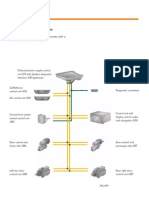Essential Electrical Skills Part 1: Techtalk
Essential Electrical Skills Part 1: Techtalk
Uploaded by
ภูเก็ต เป็นเกาะCopyright:
Available Formats
Essential Electrical Skills Part 1: Techtalk
Essential Electrical Skills Part 1: Techtalk
Uploaded by
ภูเก็ต เป็นเกาะOriginal Title
Copyright
Available Formats
Share this document
Did you find this document useful?
Is this content inappropriate?
Copyright:
Available Formats
Essential Electrical Skills Part 1: Techtalk
Essential Electrical Skills Part 1: Techtalk
Uploaded by
ภูเก็ต เป็นเกาะCopyright:
Available Formats
TECHTALK
ESSENTIAL ELECTRICAL SKILLS PART 1
This article is the first in a series from ProAuto to assist the workshop technician in the development of electrical and electronic diagnostic skills. A thorough understanding of the first, two-part article Essential electrical skills is, as the title suggests, essential if a thorough understanding of those to follow is to be achieved. Future subject areas: Multiplex / CAN Databus ABS Chassis control systems (VSC, EBD, TRC, Brake Assist) Diagnostic techniques Hybrid technology electrons. Every material has different numbers of these parts, which determines its electrical characteristics. The protons and the neutrons are grouped together in the centre of the atom making up the nucleus. The important bit of the atom for someone wishing to understand current is the electron, which continuously "orbits" the nucleus, held in place by magnetic attraction. When an external pressure (voltage) is applied to an atom, it acts on the invisible bond between the nucleus and the electron, forcing the electron to "jump" away. The moving electron cannot avoid hitting another atom, forcing its electron to jump away as well. This process continues as long as electrical pressure is available and is similar to what happens when a snooker player "breaks" a pack of snooker balls. The quantity of electrons jumping through a conductive material is defined as the current flow. If you were able to count the electrons moving through a conductive material at any point, and timed it, you would be able to work out the current flow. Just as water flow through a hose can be measured in, say, litres per hour, flow of current can be measured in electrons per second. For simplicity, 625 trillion electrons moving past a single point in a conductor in 1 second is called one Amp (A). It is this process of electrons passing through an electrical consumer (motor, bulb etc.) that actually makes the consumer do work, i.e. a bulb glowing or a motor rotating. Up to a point, the more electrons (amps) that flow through an electrical consumer, the more work will get done. This current flow must be controlled as too much flowing through a consumer can result in damage. Resistance As we have already seen, current flow is the amount of electrons passing through a conductor over a time period. If a high current flows, lots of work can be done, i.e. a starter motor cranking an engine. Lower power devices will be damaged if the current flow is excessive and some sort of restriction to current flow must be provided. In electrical terms this is known as Resistance (R). This resistance may be a component incorporated into the device itself or as a separate component in the circuit. Some components have natural resistance in the materials from which they are constructed - lamps are an example of this. Materials used in electrical circuits have different resistances, enabling them to conduct (carry) electricity at different rates. A good conductor will have a low resistance; a poor conductor will have a high resistance. Resistance is measured in Ohms (). Measuring current Although not commonly used, an ammeter can provide a good deal of information about a circuits condition. To measure current, the ammeter is connected in series with the circuit or part of the circuit you wish to test. The ammeter becomes part of the circuit and measures all current passing through it. Any resistances (consumers) in the circuit will prevent high current flowing, just as they would when in normal operation.
ESSENTIAL ELECTRICAL SKILLS THE SHOULD KNOWS
Voltage Voltage can be defined as pressure supplied to an electrical circuit, pretty much the same as water pressure supplied to a tap or valve. Imagine a vehicle battery as a tank containing a pump constantly supplying pressure to a selfsealing valve at the positive terminal. The electrical pressure acting outwardly from the positive terminal of the battery is normally about 12 Volts (12V). The negative terminal of the battery is the low-pressure (0.0V) "topup" filler for the tank/pump. Nothing happens when the battery is in this state because the "valve" is closed. A length of wire (hose) attached to the negative terminal with its open end in air makes no difference. If the open end of this wire is then connected to the valve at the positive terminal, thus joining the two terminals together, the valve automatically opens, allowing "electricity" to easily flow to the negative terminal. This flow is called Current. As can be imagined, because the pressure difference is large (12V) and with no restrictions in the hose, the current flow will be very high (burned fingers anyone?) Current All materials, including those used in electrical wiring, are made up of atoms. Each atom has three main parts: protons, neutrons and
The ammeter should never be connected in parallel with a consumer on the circuit. If that consumer is the only resistance in that circuit, the ammeter creates an effective short circuit (an easier route for the current to take through little or no resistance) and excessive current will by-pass the consumer directly through the
30 MAY 05 MOTOR INDUSTRY MAGAZINE
WWW.MOTOR.ORG.UK
ammeter to earth. At best this will lead to a blown fuse in the ammeter, damaged circuits/ammeter or even a fire.
THE MUST KNOWS
The four key rules With a clear appreciation of voltage, current and resistance, it should be easier to understand the testing of voltage in a circuit. Note:Throughout the following, reference to a black probe refers to the negative or earth probe on a voltmeter. Reference to a red probe refers to what is commonly known as the positive probe. These colours may vary on different equipment. Four key rules can be applied when using voltmeters to test circuits: Rule 1 A digital voltmeter displays the difference in voltage between where you place the black probe to where you place the red probe. Rule 2 The voltage after the last resistance in a circuit will always be zero, providing current can flow. Rule 3 Volt drop will occur across a resistance, providing current can flow. Rule 4 The volt drop across a resistance in a series circuit is in direct proportion to the comparative resistances values.
Rule 1: Example 2 The red probe is probing the circuit where there is 12 Volts directly from the battery. The black probe is probing the same section of the circuit where there is also 12 Volts. There is no difference between these two readings so the meter will display 0V (no difference).
Rule 2: Example 2 We now have three lamps placed in a row (in series). The current will flow through lamp 1 first, then through lamp 2 and finally through lamp 3, which is the last resistance in the circuit. Therefore, any part of the circuit after lamp 3 will have 0 Volts present. Rule 1: Example 3 The red probe is probing the circuit where there is 12 Volts. The black probe is probing the circuit where there is 0 Volts. The meter displays the difference between 12V and 0V, which is 12V.
PROVING THE RULES:
Rule 1: Example 1 A digital voltmeter displays the difference in voltage between where you place the black probe to where you place the red probe. The red probe is probing the earth part of the circuit where there is 0 Volts. The black probe is probing the same section of the circuit where there is also 0 Volts. There is no difference between these two measurements; therefore the meter will display 0V (no difference).
Using this rule to measure voltage at any point in a circuit, place the black probe on earth (a point in the circuit which is ultimately connected to the negative earth terminal, where 0 Volts is present) and place the red probe wherever you wish to measure the voltage. Rule 2: Example 1 The voltage after the last resistance in a circuit will always be zero providing current can flow. If we assume current flows from the positive post of the battery to the negative post, the first resistance for current to flow through would be the lamp. More importantly, the lamp is also the last resistance that the current flows through. Therefore any part of the circuit after the lamp will have 0 Volts present.
Rule 3 Volt drop will occur across a resistance, providing current can flow. There is now a break in the circuit after point "c". This means current is no longer able to flow anywhere in the circuit. Rule 3 states that a voltage drop will only occur across a resistance when current can flow. In this case, therefore, none of the resistances (the lamps) can cause a drop in voltage. In this example, if the black probe of the voltmeter were placed at a point in the circuit attached to the negative post of the battery and the red probe anywhere else in the circuit up to point "c" (the lamp side of the break), 12 Volts would be displayed.
WWW.MOTOR.ORG.UK
MOTOR INDUSTRY MAGAZINE MAY 05 31
TECHTALK
Rule 4 The Volt drop across a resistance in a series circuit is in direct proportion to the comparative resistances values. It should now be clear that voltage measured anywhere from the battery positive post to Lamp 1 will be 12V. It is equally clear that measuring voltage anywhere between Lamp 2 and the negative post of the battery will produce a reading of 0V. This means that the voltage drop caused by the resistances of lamp 1 and lamp 2 together must total 12V. If both lamps have the same resistance, they will both restrict current flow the same amount, which will in turn lead to an equal voltage drop. In this case a drop of 6V will occur at each lamp. The voltage measured between the lamps will be 6V (12 minus 6 = 6) Note: The actual resistance is irrelevant as long as they are the same. Comparative values means the individual resistances compared with each other.
resistance of lamp 2 is 1. A simple formula can be used to calculate voltage drop across resistances in a series circuit when you know all the resistances. This can be used as one way of finding out whether an extra, unwanted resistance is present (poor connection etc). After calculating what the voltage drops should be and then measuring the actual values, any discrepancy will be easily seen.
DIAGNOSIS APPLYING THE RULES
Example 1
Supply Voltage = Volt drop per Total circuit resistance * 12 6* = 2 Volts drop per
* Note: When calculating the total circuit resistance of a series circuit you simply add all the resistance values together. This formula has allowed us to calculate how much of a Voltage drop is going to occur across each Ohm () of resistance, in this case 2V per . The 5 lamp 1 will cause a 10 Volts drop and the 1 lamp 2 will cause a 2 Volts drop. Now we have to calculate what the voltage would be in between lamp 1 and lamp 2. We know 12V is being applied to the positive side of lamp 1, and we know that a volt drop of 10V occurs over it. If we start off with 12V and a drop of 10V occurs we must have 2V left over. That means the voltage in between lamp 1 and lamp 2 must be 2V. This means there is 2V of electrical pressure acting upon the positive side of lamp 2. We have already calculated that a volts drop of 2V occurs over lamp 2 and so the voltage on the negative side of lamp 2 must be 0V. We already know this to be correct, due to what we have learnt from rule 2. A thorough understanding of these four rules is essential if the diagnosis of a faulty circuit is to be fast and accurate. The rules have taught us what will occur in a good circuit, and so it will be possible for us to work out what the various voltages around that circuit should be. If we know what the voltages should be, and they are not as expected, the fault can be easily identified through effective digital multimeter use.
The circuit pictured has a fault. The lamps should be illuminated but they are not. If we test the circuit at all the points labelled we will be able to work out where the fault must be. We have tested the circuit in the order of the results below: a = 12V b = 12V c = 12V d = 12V e = 12V f = 0V. So where is the fault? Lets apply the rules: When we measured the voltage at point "a" and found there to be 12V we know the battery is OK. When we measured 12V at point "b" we know the wire joining points "a" to "b" must be OK (as electrical pressure is managing to act at point "b"). If the wire were broken, the voltage here would have been 0V. At the point of measuring 12V at point "c", we know we must have an open circuit (physical break). We know this to be true because current cant be flowing through the circuit, as volts drop has not occurred over lamp 1 (reference rule 3). Only a break in a circuit will prevent current from flowing. At the point of measuring 12V at point "d", we know the wire is OK in between point "c" and point "d" as 12V is able to act upon lamp 2. At the point of measuring 12V at point "e" we know that the filament in lamp 2 is OK as electrical pressure is able to act through it. This also tells us that the open circuit (break) must lie in between point "e" and point "f". Just to be certain, when we measure the voltage at point "f" and find the voltage to
Rule 4 states that the volts drop across each resistance is relative to its comparative resistance. This means that if you have more than one resistance (consumer) in a series circuit, the highest resistance in that circuit will create the largest volt drop and the lowest resistance the lowest drop. The total volts drop across all of the consumers must add up to the supply voltage value. In this circuit the resistance of lamp 1 is 5 and the
32 MAY 05 MOTOR INDUSTRY MAGAZINE
WWW.MOTOR.ORG.UK
be 0V, we can be sure that we have come to the correct conclusion. Now that we know where the fault lies, we know where we need to look visually in the circuit to locate the break.
The answer is given at the end of this article. a = 12V b = 12V c = 12V d = 0V e = 0V Congratulations if you were correct! If not, study this article again or attend one of our courses and well get you completely involved in the application of these rules to real circuits to aid your understanding. Please visit our website at www.proautotraining .com for further details. In summary In the second part to this article we will be discussing other types of faults. These will include short circuits on both supply and earth sides (the latter often being referred to as
PROGRESS CHECK!
parasitic drain) and also high resistance faults. We will also be sharing with you our tricks of the trade, to enable to you accurately diagnose faults very quickly and confidently. Answer to progress check: There must be a break in the wire between point "c" and point "d". ProAuto is an automotive technical training company based in Shrewsbury, Shropshire. Its core business is the design and delivery of technical training to the automotive industry, which includes vehicle manufacturers, component manufacturers, diagnostic equipment manufacturers and independent garages. The company runs courses from numerous venues nationally. Further details on www.proautotraining.com, email info@ proautotraining.com, or telephone 01743 709679.
Where do you think the fault lies? Use the measured voltage values listed below to identify the problem.
DEAR DAVE
A 1997 Golf GTi with Simos management system has a very poor idle. Most of the time its below 600 rpm, and on a cold start it cuts out for the first five minutes. No fault codes are stored. We have cleaned out the throttle housing, replaced all plugs and HT leads, checked fuel pressure and flow. Emissions are good and the car otherwise drives normally. The only abnormality is that with the engine stopped and the ignition on, the throttle motor keeps operating. Throttle potentiometer readings and idle switch have been checked and shown as normal. Our scan tool will not respond to the throttle adaptation procedure. This sounds like a faulty throttle positioning motor. These motors often draw excessive current. The ECU tries to make the motor move without success and finishes up fighting the motor all the time. The same fault will make it impossible to run through the throttle adaptation procedure. After fitting a new motor it has to be re-programmed to the ECU. These motors are a bit pricey though, so I would also monitor the throttle potentiometer readings closely on cold running, and check the output from the main engine relay at the same time as this could cause the stalling though it wouldnt affect the idling quality. A Rover 100 with Mems single point injection runs all right at light throttle openings, but anything over that it misfires badly and loses power. No fault codes stored. Lambda sensor checks out OK and emissions are good. The catalyst has been checked for excessive back pressure on the road while the fault is occurring and reads 1.0 Psi. The engine pinks sometimes so we suspected a weak mixture. Monitoring the injection pulses when the fault occurs has not helped, though fuel delivery looks normal. Vacuum readings measured from a scan tool shows 19 inches at idle, and 3 inches on wide open throttle, so it looks like the pressure transducer in the ECU is OK. I suspect the ECU itself. First check the fuel pressure and flow. I dont know if you have checked the ignition system in detail; it could be an ignition fault a faulty rotor arm, distributor cap, HT leads or HT coil could all cause this fault. You need over 35 Kv coil output from the system to cope with full power ignition requirements. If the ignition is all right, then have the ECU checked first by a specialist before replacement. A Ford Mondeo 1995 1.8 has a misfire and power loss all the time. Fault codes are logged as code 327 (EVP, DPFE, EGR) and also for the Lambda sensor. The management system stays in open loop all the time, with the sensor voltage sticking at 100 mv. The EGR valve appears to be working since applying vacuum to it at idle makes the engine stall. Vacuum pipes have been checked, along with catalyst back pressure, fuel pressure and fuel flow. The fault codes associated with all these circuits concern the EGR (exhaust gas recirculation ) system. The first, EVP, is the EGR operating valve position sensor this tells the ECU the opening position of the EGR valve. DPFE (differential pressure feedback exhaust sensor) uses the pressure in the exhaust to calculate the
WWW.MOTOR.ORG.UK
MOTOR INDUSTRY MAGAZINE MAY 05 33
You might also like
- 6HP26 ZF Transmissions With MechatronicsDocument66 pages6HP26 ZF Transmissions With MechatronicsSalman Eid100% (1)
- Path of Electrons Through The Resistor and Not Across A Source of Voltage. To Do ThisDocument4 pagesPath of Electrons Through The Resistor and Not Across A Source of Voltage. To Do ThisHassan AbdoNo ratings yet
- EE 442 Laboratory Experiment 2 Introduction To The Measurement of Voltage, Current, Resistance and Voltmeter LoadingDocument12 pagesEE 442 Laboratory Experiment 2 Introduction To The Measurement of Voltage, Current, Resistance and Voltmeter LoadingAdrien Munyaneza100% (1)
- DC CircuitsDocument83 pagesDC CircuitsC WaiteNo ratings yet
- Tel20104 Lab 6 & 7 PDFDocument19 pagesTel20104 Lab 6 & 7 PDFNur HidayahNo ratings yet
- 07 OhmsLawAndCircuitsDocument18 pages07 OhmsLawAndCircuitsRashaq AlheetyNo ratings yet
- Experiment I: Ohm's Law and Not Ohm's LawDocument14 pagesExperiment I: Ohm's Law and Not Ohm's LawPhillip PopeNo ratings yet
- Chapter 2 DC Circuit TheoryDocument37 pagesChapter 2 DC Circuit TheoryTynoh MusukuNo ratings yet
- 114 214ohmDocument11 pages114 214ohmHikmat Saeful BahriNo ratings yet
- I DQ DT: Topic 1: Basic Concepts 1.0 CurrentDocument11 pagesI DQ DT: Topic 1: Basic Concepts 1.0 Currentkumares_nfbmNo ratings yet
- Electronics Engineering Notes Unit 1st YearDocument11 pagesElectronics Engineering Notes Unit 1st Yearmahvs.1311No ratings yet
- Chapter 2: DC Circuit TheoryDocument37 pagesChapter 2: DC Circuit TheoryTaonga Nhambi100% (1)
- High Voltage OhmmetersDocument12 pagesHigh Voltage Ohmmetersgeyigi5567No ratings yet
- Text in EnglishDocument15 pagesText in EnglishMartin GeorgievNo ratings yet
- GR 10 ElectricityDocument54 pagesGR 10 Electricitymaseditebatso6No ratings yet
- Electronics GuideDocument22 pagesElectronics GuideFernandes KennethNo ratings yet
- DC CircuitsDocument26 pagesDC CircuitsMary Jean ParagsaNo ratings yet
- Definition As Potential of Electric Field: VolatgeDocument4 pagesDefinition As Potential of Electric Field: VolatgecarolinaNo ratings yet
- Digital ElectronicsDocument116 pagesDigital ElectronicsAravinth CpNo ratings yet
- ElectricityDocument85 pagesElectricityapi-2851792610% (1)
- Series and Parallel Circuits: TutorialDocument18 pagesSeries and Parallel Circuits: TutorialBrendan Lewis DelgadoNo ratings yet
- Instituto Politécnico Nacional: Escuela Superior de CómputoDocument3 pagesInstituto Politécnico Nacional: Escuela Superior de CómputoWilliam IzzoNo ratings yet
- Interstate Batteries Automotive Electrical Clinic 2019 01 15 Interstate BatteriesDocument9 pagesInterstate Batteries Automotive Electrical Clinic 2019 01 15 Interstate Batteriesmecanidec La MotteNo ratings yet
- Experiment 1 MendozaDocument20 pagesExperiment 1 MendozaBenj MendozaNo ratings yet
- Electric Circuits: Honors PhysicsDocument24 pagesElectric Circuits: Honors PhysicsDhanalakshmi VadivelanNo ratings yet
- Test Device4Document6 pagesTest Device4Hassan AbdoNo ratings yet
- MEO Class 4 Exam - Electrical Oral Question & Answers PDFDocument6 pagesMEO Class 4 Exam - Electrical Oral Question & Answers PDFabhishek rathourNo ratings yet
- Topics To Be Covered: Unit-2: Basic Circuit ElementsDocument11 pagesTopics To Be Covered: Unit-2: Basic Circuit ElementsParthaNo ratings yet
- Unit 1: Chemical Effects of Electric Current Faraday'S Laws of ElectrolysisDocument13 pagesUnit 1: Chemical Effects of Electric Current Faraday'S Laws of ElectrolysisRajesh JagadeesanNo ratings yet
- Por Tony R. KuphaldtDocument10 pagesPor Tony R. KuphaldtMiguel PittaNo ratings yet
- Lessons in Electric CircuitsDocument82 pagesLessons in Electric Circuitsjun dee100% (3)
- MODULE 5 TABAOelectricity and CircuitsDocument13 pagesMODULE 5 TABAOelectricity and Circuitsannetabao01No ratings yet
- Basics of Electricity/Electronics: Description Get It FromDocument12 pagesBasics of Electricity/Electronics: Description Get It FromMohammed Abu SufianNo ratings yet
- Introduction To Electronics Theory: English For EEITDocument64 pagesIntroduction To Electronics Theory: English For EEITYou Can Shine AtomNo ratings yet
- Experiment No 1Document8 pagesExperiment No 1mahamchudry2No ratings yet
- Analog and Digital Meters Assignment 2Document2 pagesAnalog and Digital Meters Assignment 2Caleb MaffinNo ratings yet
- VOLTAGE DROP Testing Overview and Lab SheetDocument6 pagesVOLTAGE DROP Testing Overview and Lab SheetSabastian Edwards100% (1)
- Motors: Why Starters Are Not Used For Land Based Installations?Document12 pagesMotors: Why Starters Are Not Used For Land Based Installations?avm4343100% (1)
- Testing of Continuity in Switches and LoadDocument7 pagesTesting of Continuity in Switches and LoadVikas UpadhyayNo ratings yet
- Practical No. 6:: Practical To Verify The Ohm's LawDocument4 pagesPractical No. 6:: Practical To Verify The Ohm's Lawعبدالمقیت مرزاNo ratings yet
- AC CircuitsDocument47 pagesAC CircuitsC Waite100% (1)
- Electric Circuits: AP Physics BDocument24 pagesElectric Circuits: AP Physics Banon_502501856No ratings yet
- Exp1 The Single Phase TransformerDocument8 pagesExp1 The Single Phase Transformernaveen rajNo ratings yet
- Basic ElectronicsDocument19 pagesBasic ElectronicsRavitchandiran RNo ratings yet
- DC Component AnalysisDocument9 pagesDC Component Analysisvivianzhu120No ratings yet
- CLASS 9 CBSE CH-12 ElectricityDocument63 pagesCLASS 9 CBSE CH-12 ElectricityannigarwalNo ratings yet
- Activity 2 Measurement DiscussionDocument5 pagesActivity 2 Measurement DiscussionJoel Kelly MabaoNo ratings yet
- Galant CH 6 Chassis Electrical PDFDocument76 pagesGalant CH 6 Chassis Electrical PDFjustcheerfulNo ratings yet
- CSS 12 - Lesson 3 (Fundamentals of Electronics)Document3 pagesCSS 12 - Lesson 3 (Fundamentals of Electronics)Jonel RivasNo ratings yet
- Annex B Relay Construction: Protection Systems & Devices (Relays) 3 YearDocument3 pagesAnnex B Relay Construction: Protection Systems & Devices (Relays) 3 Yearnassim.1979No ratings yet
- 2 Ohm's Law: ExperimentDocument25 pages2 Ohm's Law: ExperimentSabling DritzcNo ratings yet
- Atb1128 DodgeDocument6 pagesAtb1128 Dodgeภูเก็ต เป็นเกาะNo ratings yet
- 4T65R Erratic Shift, 1 2 ShuddleDocument1 page4T65R Erratic Shift, 1 2 ShuddleAlitar HersongollsNo ratings yet
- SSP 269 d1 PDFDocument60 pagesSSP 269 d1 PDFAdrian BuzasNo ratings yet
- Article 0001 Ravigneaux Planetary TransmissionDocument9 pagesArticle 0001 Ravigneaux Planetary Transmissionthisisjinesh100% (1)
- SSP 299 6 SP Manual Gearbox 08DDocument44 pagesSSP 299 6 SP Manual Gearbox 08DvasilealexandruNo ratings yet
- SSP 286 New Data Bus SystemsDocument30 pagesSSP 286 New Data Bus Systemsภูเก็ต เป็นเกาะNo ratings yet
- SSP 296 1.4 & 1.6 FSi EngineDocument16 pagesSSP 296 1.4 & 1.6 FSi Engineaz3ki3lNo ratings yet
- SSP 298 Touareg ElectricsDocument29 pagesSSP 298 Touareg Electricsภูเก็ต เป็นเกาะ100% (1)
- SSP 297 TouaregDocument56 pagesSSP 297 Touaregภูเก็ต เป็นเกาะ100% (1)
- SSP 296 1.4 & 1.6 FSi EngineDocument24 pagesSSP 296 1.4 & 1.6 FSi Engineภูเก็ต เป็นเกาะ100% (3)
- SSP 276 Phaeton Proximity ControlDocument40 pagesSSP 276 Phaeton Proximity Controlภูเก็ต เป็นเกาะ100% (1)
- SSP 286 New Data Bus SystemsDocument26 pagesSSP 286 New Data Bus Systemsภูเก็ต เป็นเกาะ100% (1)
- SSP 279 2.0 FSiDocument44 pagesSSP 279 2.0 FSiภูเก็ต เป็นเกาะ0% (1)
- SSP 280 Phaeton Auxillary HeaterDocument25 pagesSSP 280 Phaeton Auxillary HeaterButnaru EmanuelNo ratings yet
- SSP 277 Phaeton ChassisDocument60 pagesSSP 277 Phaeton Chassisภูเก็ต เป็นเกาะNo ratings yet
- SSP 281 New Beetle CabrioletDocument40 pagesSSP 281 New Beetle Cabrioletภูเก็ต เป็นเกาะNo ratings yet
- SSP 275 Phaeton Air SuspensionDocument21 pagesSSP 275 Phaeton Air Suspensionภูเก็ต เป็นเกาะ100% (1)
- SSP 271 Phaeton Heating & ACDocument76 pagesSSP 271 Phaeton Heating & ACภูเก็ต เป็นเกาะNo ratings yet
- SSP 273 Phaeton ConvenienceDocument29 pagesSSP 273 Phaeton Convenienceภูเก็ต เป็นเกาะNo ratings yet
- SSP 273 Phaeton ConvenienceDocument23 pagesSSP 273 Phaeton ConvenienceButnaru EmanuelNo ratings yet
- SSP 275 Phaeton Air SuspensionDocument17 pagesSSP 275 Phaeton Air Suspensionภูเก็ต เป็นเกาะNo ratings yet
- SSP 274 Phaeton InfotainmentDocument40 pagesSSP 274 Phaeton Infotainmentภูเก็ต เป็นเกาะNo ratings yet
- SSP 269 d1 PDFDocument60 pagesSSP 269 d1 PDFAdrian BuzasNo ratings yet
- SSP 272 Phaeton ObpsDocument27 pagesSSP 272 Phaeton Obpsภูเก็ต เป็นเกาะNo ratings yet
- SSP 265 Vehicle Electrics in Polo MY 02Document24 pagesSSP 265 Vehicle Electrics in Polo MY 02ภูเก็ต เป็นเกาะNo ratings yet
- SSP 264 Brake AssistDocument16 pagesSSP 264 Brake Assistภูเก็ต เป็นเกาะNo ratings yet
- SSP 265 Vehicle Electrics in Polo MY 02Document24 pagesSSP 265 Vehicle Electrics in Polo MY 02ภูเก็ต เป็นเกาะ100% (1)
- SSP 264 Brake AssistDocument16 pagesSSP 264 Brake Assistภูเก็ต เป็นเกาะ100% (1)
- Rev A SmallDocument35 pagesRev A SmallMax TerlNo ratings yet
- Service Manual: DPS-V55/V55MDocument32 pagesService Manual: DPS-V55/V55MQuiruNo ratings yet
- Department of Education: Republic of The PhilippinesDocument11 pagesDepartment of Education: Republic of The Philippinesmarjie adameNo ratings yet
- Lab Report#01: Electrical Measurements and Instrumentations Submitted To: Submitted By: Reg No.: DateDocument13 pagesLab Report#01: Electrical Measurements and Instrumentations Submitted To: Submitted By: Reg No.: Datemuhammad3soba-810071No ratings yet
- PIC-based Digital Voltmeter (DVM) - Embedded LabDocument68 pagesPIC-based Digital Voltmeter (DVM) - Embedded LabWinston WolfNo ratings yet
- 284-46 MID 128 SID 1-2-3-4-5-6 InjectorsDocument7 pages284-46 MID 128 SID 1-2-3-4-5-6 InjectorsElio Custodio Huachaca67% (6)
- Manual Multimetro Goldstar dm-332 - CalDocument13 pagesManual Multimetro Goldstar dm-332 - Calav100% (2)
- Testing & Commissioning ManualDocument37 pagesTesting & Commissioning ManualVenkata Raja Suresh J100% (2)
- 793f Ac Hoist SystemDocument30 pages793f Ac Hoist SystemJorge Sandro Uribe AguilarNo ratings yet
- Workshop Final Latest 1Document31 pagesWorkshop Final Latest 1tesfayeNo ratings yet
- Internet of Things Hardware Development 9Document16 pagesInternet of Things Hardware Development 9aizii.n110No ratings yet
- Fluke 754 Process Calibrator DatasheetDocument11 pagesFluke 754 Process Calibrator DatasheetJose Uriel Ortega LeonNo ratings yet
- Troubleshooting 3412 4BZ PDFDocument18 pagesTroubleshooting 3412 4BZ PDFMounir SerguineNo ratings yet
- Chapter 4 I&PCDocument78 pagesChapter 4 I&PCshmyeNo ratings yet
- User's Manual For MT8206Document10 pagesUser's Manual For MT8206RgfNo ratings yet
- Catalog HP 2011Document368 pagesCatalog HP 2011canhtl34No ratings yet
- Replacing Damaged JacksDocument8 pagesReplacing Damaged JacksnioprenNo ratings yet
- Experiment 7: Voltmeter Using PMMC: I. ObjectivesDocument9 pagesExperiment 7: Voltmeter Using PMMC: I. ObjectivesJam Magat100% (1)
- Service ListDocument10 pagesService Listviethuong96No ratings yet
- JP00590 5Document68 pagesJP00590 5gsheetslogisticsNo ratings yet
- Lab 03Document4 pagesLab 03artistryrival100% (1)
- Nautel VS1-TROUBLESHOOT - 2.0Document155 pagesNautel VS1-TROUBLESHOOT - 2.0Ricardo GutierrezNo ratings yet
- Experiment 3 Buck ConverterDocument8 pagesExperiment 3 Buck Converterprop_kcpNo ratings yet
- Switching Sequencies in EtapDocument50 pagesSwitching Sequencies in EtapManohar Potnuru100% (1)
- Measuring Gigaohms With A Simple MultimeterDocument11 pagesMeasuring Gigaohms With A Simple MultimeterZIASY Shesmer100% (2)
- Circuit DescriptionDocument2 pagesCircuit DescriptionJorge RaulNo ratings yet
- Co2 Laser Trouble Shooting GuideDocument111 pagesCo2 Laser Trouble Shooting GuideworlsNo ratings yet
- TM 9 2320 211 20 PDFDocument371 pagesTM 9 2320 211 20 PDFGeorgeStefosNo ratings yet
- Physics As Unit 3Document12 pagesPhysics As Unit 3Muaaz IqbalNo ratings yet




















































































































